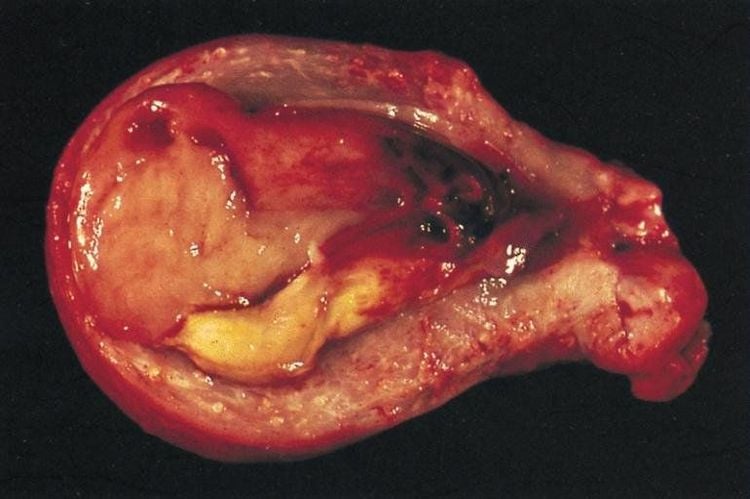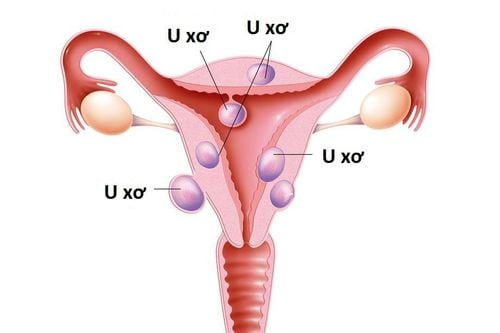This is an automatically translated article.
The article was professionally consulted by BSCK I Le Thi Phuong - Department of Obstetrics and Gynecology, Vinmec Ha Long International General Hospital.Uterine fibroids occur in about 50% of women, the majority of which are benign lesions. However, if patients with uterine fibroids are not examined, treated and monitored by a specialist, they can progress to malignant uterine fibroids and adversely affect their health. The following article will help you better understand uterine fibroids, specifically malignant uterine fibroids.
1. What are uterine fibroids?
Uterine fibroids are benign growths of smooth muscle and connective tissue of the uterus, usually surrounded by a pseudocapsule made of compressed smooth muscle fibers. Uterine fibroids may be hormone related (hyperestrogenic), they can increase in size with the use of estrogen and are most likely to shrink after menopause.Uterine fibroids include: submucosal fibroids, interstitial fibroids, and subperitoneal fibroids. Location can be found in the trunk, waist, cervix, one or more fibroids, different sizes.
2. What are malignant uterine fibroids?
Malignant uterine fibroids are understood as cancerous cases (uterine smooth muscle sarcoma - this type only accounts for about 1% of uterine fibroids cases) and cases of uterine fibroids that have many adverse effects on the body. health (a lot of bleeding; complications of bladder and ureter compression; necrotic uterine fibroids; heavy bleeding...).
3. When to think of malignant uterine fibroids?
Most patients with uterine fibroids have no symptoms. Patients may come to the clinic because of abnormal uterine bleeding, because of symptoms of pelvic compression, because of palpable pelvic mass; due to abdominal pain... or discovered by chance through ultrasound during medical examination. Most uterine fibroids are benign and do not require treatment, but they need to be examined and monitored periodically by a specialist to have an indication for intervention when there are signs of malignant uterine fibroids such as:Patient Having large uterine fibroids causing discomfort. The patient has heavy bleeding. Patient has uterine fibroids rapidly increasing in size, suspected sarcoma. The patient has uterine fibroids pressing on the bladder, ureters, causing hydronephrosis. Patients with uterine deformity in women who are contemplating pregnancy or have had recurrent miscarriages. Patients with large uterine fibroids for > 12 weeks with symptoms: Abdominal pain, hypermenorrhea, menorrhagia, ... Submucosal fibroids, heavy bleeding,...
4. Are malignant uterine fibroids curable?
Currently, along with the development of science and technology, medicine also has many new advances. The treatment of malignant uterine fibroids is performed in a safe, minimally invasive manner, bringing many health benefits to the patient.Treatment of malignant uterine fibroids in particular and treatment of uterine fibroids in general depends on the individual of each patient, depending on tumor location, tumor size, and pathological condition. accompanying patient. For each specific patient case, we will have an appropriate treatment method. Current treatments include:
Medical treatment Using oral contraceptives , progestin , and a hormonal intrauterine device (Mirena) can all reduce bleeding. Use of a GnRH agonist causes amenorrhea and can temporarily shrink fibroids, usually before surgery.
Laparoscopic hysterectomy Indications for submucosal fibroids larger than 4cm or endometrial ablation – control bleeding.
Laparoscopic surgery to remove uterine fibroids Laparoscopic surgery to remove uterine fibroids is a minimally invasive surgical method, performed by qualified and skilled doctors.
Open fibroid surgery For tumors that are too large or complex; or equipment and technical conditions are not guaranteed, open surgery can be performed safely.
Uterine fibroid embolization This is an alternative to surgery; reduces blood flow to the tumor. Most patients had a significant reduction in bleeding symptoms and a reduction in tumor size. However, more time is needed to evaluate the long-term effectiveness of this method.
Robotic surgery Uterine fibroid removal surgery uses robots for better efficiency, less invasiveness. Currently, Vinmec Hospital has implemented robotic surgery for malignant uterine fibroids, initially giving very good results, bringing many health benefits to patients.
Vinmec International General Hospital applies the robotic surgery method of treating uterine fibroids with outstanding advantages such as:
No vision restriction like traditional, optimal image quality with accuracy higher. The robot has 4 hands, equivalent to 2 surgeons, which eliminates unnecessary vibrations (hand tremors). Capable of operating in difficult positions, can move freely at 6 angles, wriggle into the smallest and deep cavities. Safe, minimize the risk of complications, surgical infection. Less pain compared to conventional surgery. Less blood loss, quick recovery, reduced hospital stay. Ensure aesthetics due to very small surgical scars. Robotic laparoscopic surgery for uterine fibroids is considered the leading method today for uterine fibroids.
Please dial HOTLINE for more information or register for an appointment HERE. Download MyVinmec app to make appointments faster and to manage your bookings easily.














